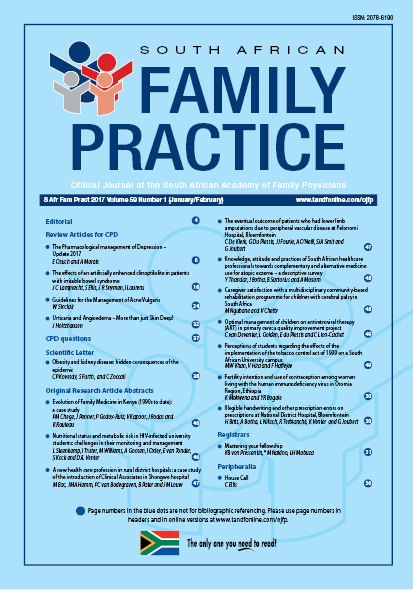Optimal management of children on antiretroviral therapy (ART) in primary care: a quality improvement project
Keywords:
child HIV, doctor involvement, primary health care, quality improvement
Abstract
Introduction: With the large volumes of human immunodeficiency virus (HIV) positive patients in South Africa, one clinical management strategy has been to task shift. This means that previously hospi-centric HIV services have devolved to primary health care (PHC) clinics. The referral pattern is true for paediatric patients as well. With the added complexity of managing children, there was a concern in the research district that children were not being optimally managed at PHC level. Method: A quality improvement project was initiated to assess HIV-positive children’s management at PHC clinics and to implement an intervention to improve this care. Results: The initial audits of 624 children in the district revealed that only 66.6% of children had undetectable viral loads (VLs). Other poor indicators were lack of regular blood results, omission of prophylactic isoniazide (INH) and cotrimoxazole etc. Documents were disorganised and not standard across the district. The intervention sought to place the local clinic doctor as the champion in each clinic. A reorganised file was planned where all the care elements would be clearly present. Conclusion: Post intervention, it was clear that where individual doctors took on the challenge of quality improvement there were significant process changes. Results are discussed in detail. (Full text of the research articles are available online at www.medpharm.tandfonline.com/ojfp) S Afr Fam Pract 2017; DOI: 10.1080/20786190.2016.1254928
Published
2017-03-06
Section
Original Research
By submitting manuscripts to SAFP, authors of original articles are assigning copyright to the South African Academy of Family Physicians. Copyright of review articles are assigned to the Publisher, Medpharm Publications (Pty) Ltd, unless otherwise specified. Authors may use their own work after publication without written permission, provided they acknowledge the original source. Individuals and academic institutions may freely copy and distribute articles published in SAFP for educational and research purposes without obtaining permission.

